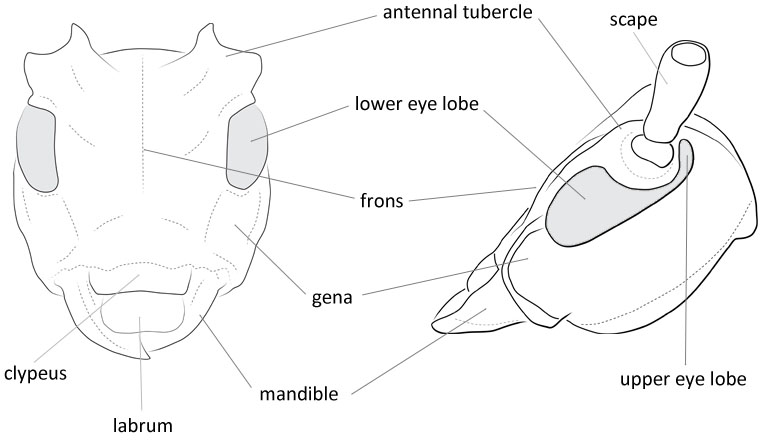Body length: 3–7 mm.
Eyes: eye interommatidial setaeseta:
a sclerotized hair-like projection of the cuticle
present, eye entire/shallowly emarginateemarginate:
notched at the margin , eye ommatidial density fine.
, eye ommatidial density fine.
Antennaeantenna:
in larval and adult insects, paired segmented appendages, borne one on each side of the head, functioning as sense organs and bearing a large number of sensilla
: antennal length reaches between basebase:
the part of any appendage or structure that is nearest the body
and end of elytraelytron:
the leathery forewing of beetles, serving as a covering for the hind wings, commonly meeting opposite elytron in a straight line down the middle of the dorsum in repose
or reaching/surpassing end of body, antennal flagellar segments elongateelongate:
much longer than wide
, scapescape:
the first proximal segment of the antenna cicatrix (scar) at apexapex:
cicatrix (scar) at apexapex:
end of any structure distad to the base
, antennal scapescape:
the first proximal segment of the antenna ≥ segment 3.
≥ segment 3.
Pronotumpronotum:
the upper and dorsal part of the prothorax
: pronotumpronotum:
the upper and dorsal part of the prothorax
shape transversetransverse:
broader than long
, rarely subquadratesubquadrate:
not quite a square
, pronotumpronotum:
the upper and dorsal part of the prothorax
lateral armature absent.
Prosternum: prosternal processprosternal process:
a posterior extension of the prosternum between the coxae not dilated at apexapex:
not dilated at apexapex:
end of any structure distad to the base
, procoxal cavities open posteriorly.
Elytraelytron:
the leathery forewing of beetles, serving as a covering for the hind wings, commonly meeting opposite elytron in a straight line down the middle of the dorsum in repose
: elytral length partial and revealing hind wings, elytral apicesapex:
end of any structure distad to the base
rounded or truncatetruncate:
cut off squarely at the tip
, elytral color brown, reddish, or orange, elytral color pattern absent.
Legs: visible tarsomerestarsomere:
subdivision or article of the tarsus, usually numbering from two to five : 4, femora clavateclavate:
: 4, femora clavateclavate:
thickening gradually toward the tip
, protibial spursprotibial spur:
sclerotized spine(s) located at the distal tibia; can be single, double, or absent : 2, tarsal clawstarsal claw:
: 2, tarsal clawstarsal claw:
usually paired claws of the pretarsus, at the distal end of the leg simple.
simple.
Head nearly flat between antennaeantenna:
in larval and adult insects, paired segmented appendages, borne one on each side of the head, functioning as sense organs and bearing a large number of sensilla
, palpi very slender; eyes very feebly emarginateemarginate:
notched at the margin . Pronotumpronotum:
. Pronotumpronotum:
the upper and dorsal part of the prothorax
transversetransverse:
broader than long
. Elytraelytron:
the leathery forewing of beetles, serving as a covering for the hind wings, commonly meeting opposite elytron in a straight line down the middle of the dorsum in repose
a little dehiscent, leaving two to several abdominal segments exposed, apicesapex:
end of any structure distad to the base
broadly and separately rounded. Legs moderately elongateelongate:
much longer than wide
; femora clavateclavate:
thickening gradually toward the tip
; posterior tarsitarsus:
the leg segment distal to the apex of the tibia, bearing the pretarsus; consists of one to five tarsomeres (including pretarsus)
with first segment longer than 2 following together (Linsley 1963Linsley 1963:
Linsley EG. 1963. The Cerambycidae of North America. Part IV. Taxonomy and Classification of the Subfamily Cerambycinae, Tribes Elaphidionini Through Rhinotragini. University of California Publications in Entomology, Vol. 21. 165 pp.).
Methia has non-clavate femora, antennaeantenna:
in larval and adult insects, paired segmented appendages, borne one on each side of the head, functioning as sense organs and bearing a large number of sensilla
substantially longer than body, and a generally fragile appearance. The abbreviated elytraelytron:
the leathery forewing of beetles, serving as a covering for the hind wings, commonly meeting opposite elytron in a straight line down the middle of the dorsum in repose
will separate Nathrius from Gracilia.
Native to Europe, introduced in western United States, Argentina, Chile, Uruguay
Many broadleaf trees and bushes; Cedrus, Pinus, Abies; Cupressus sempervirens
Three species. Conifers: N. brevipennis. Can exploit wickerwork, in natural forests species acts as a twig borer (Linsley 1933Linsley 1933:
Linsley EG. 1933. A European longicorn new to California (Coleoptera Cerambycidæ). The Pan-Pacific Entomologist, San Francisco 9(4): 170.).
Leptidea Mulsant, 1839
Leptideella Strand, 1936
Deuteroleptidea Paclt, 1946
Nathrius Brethes, 1916